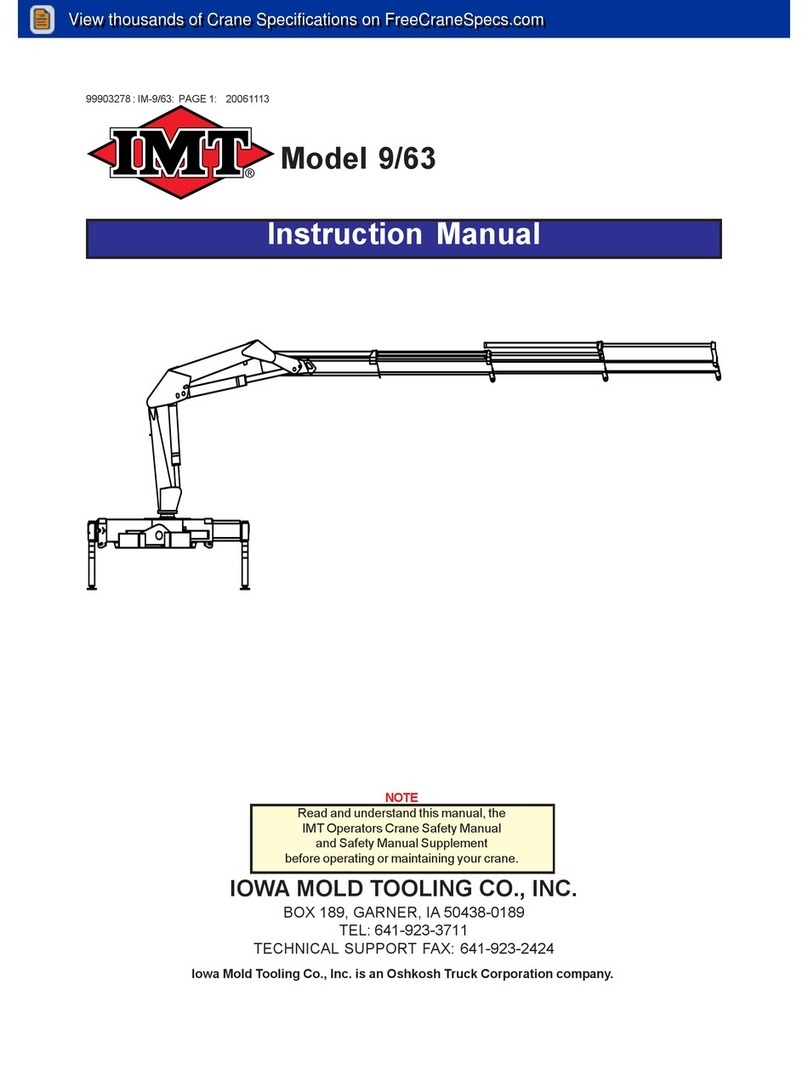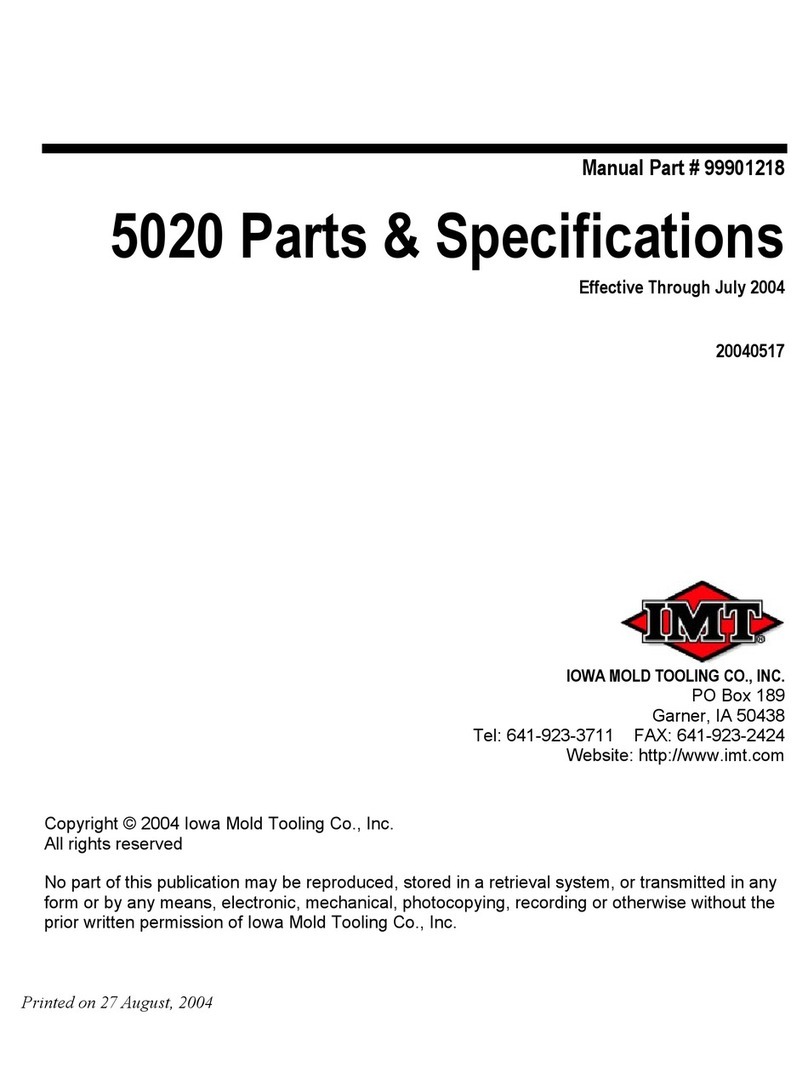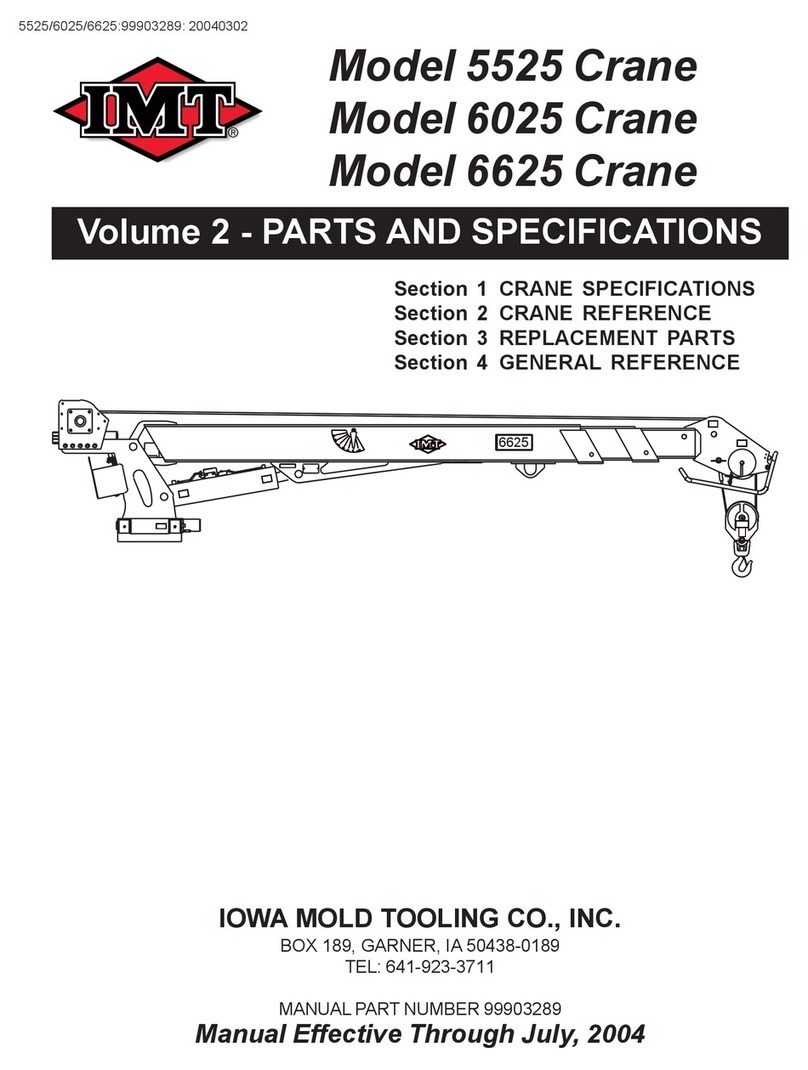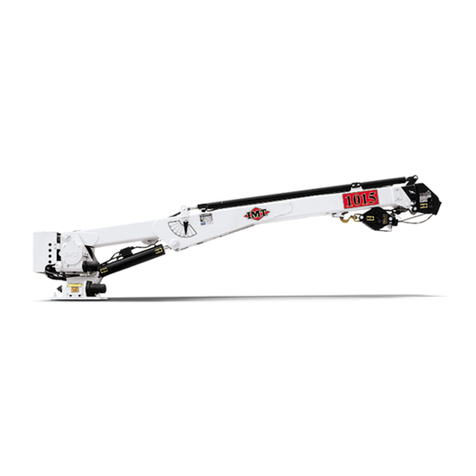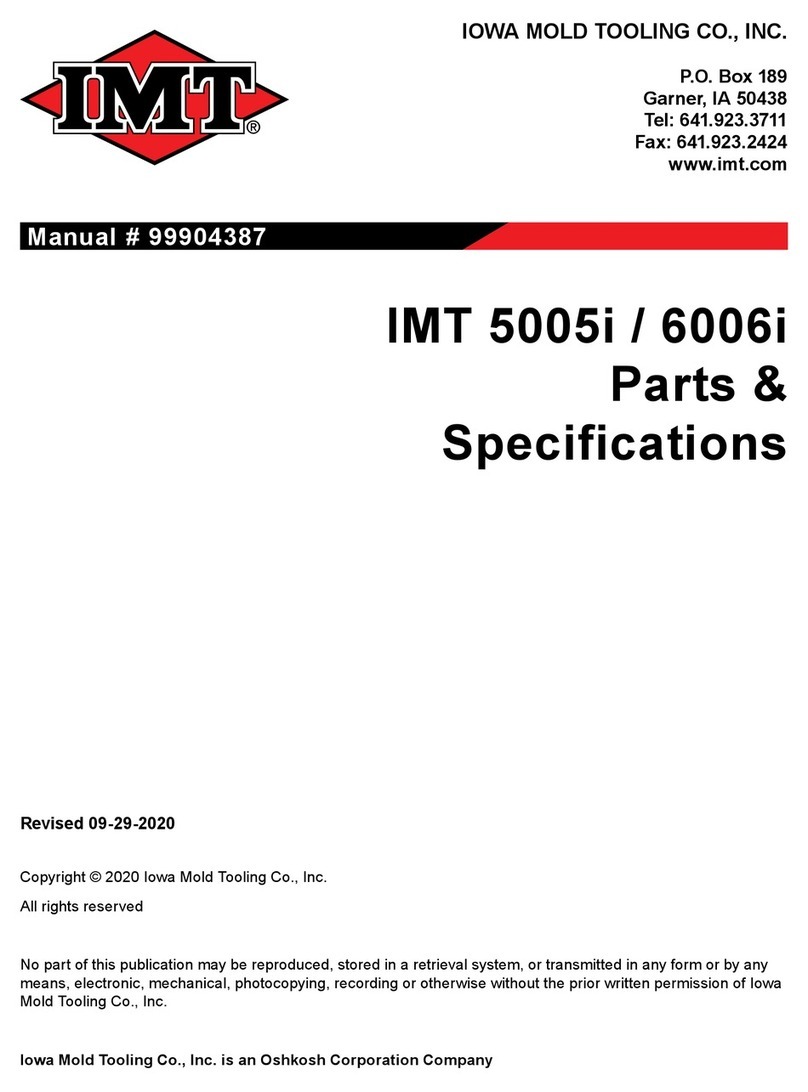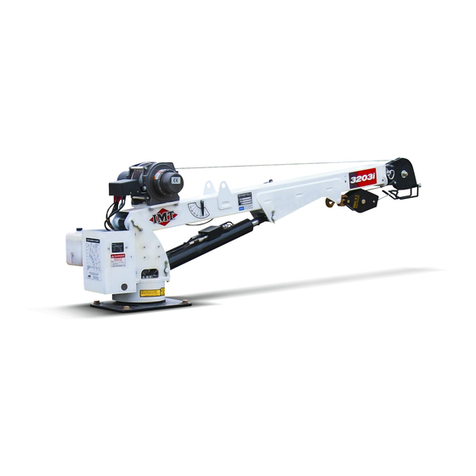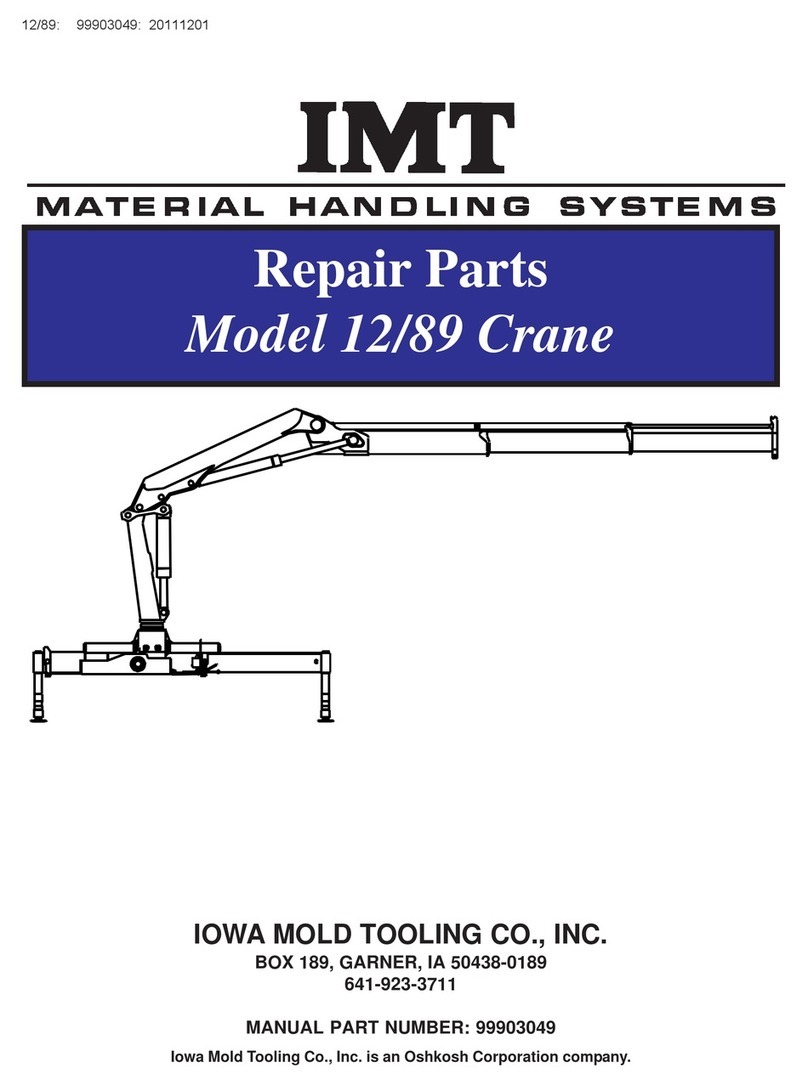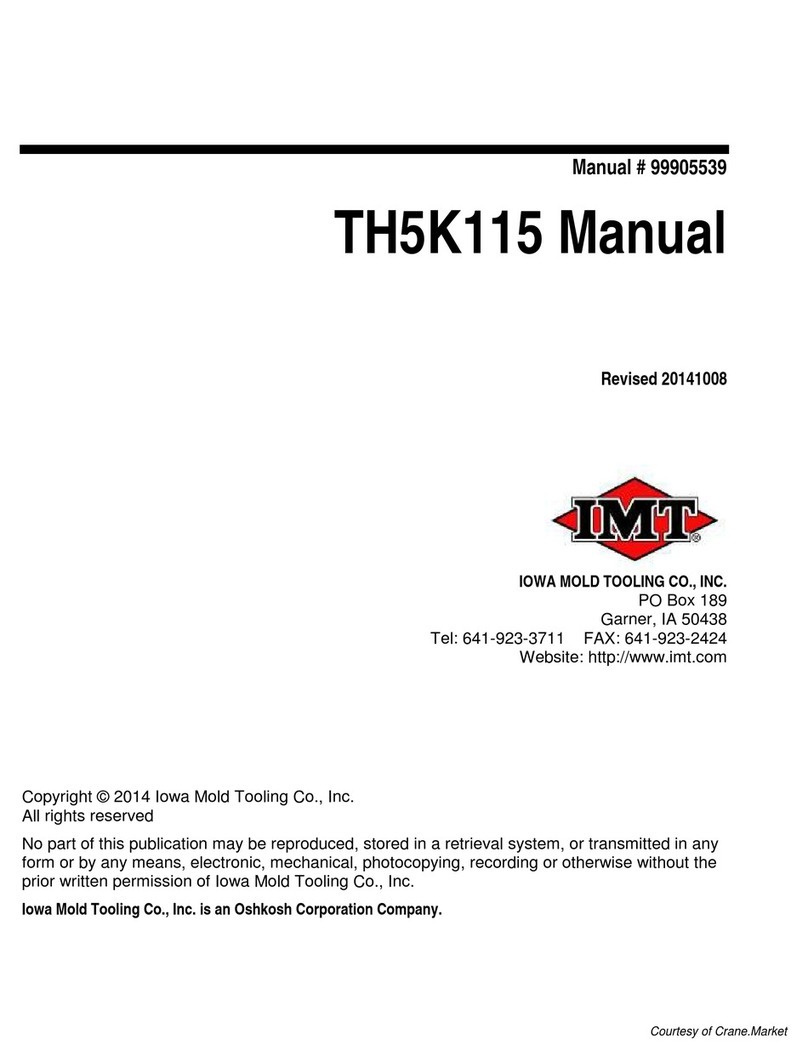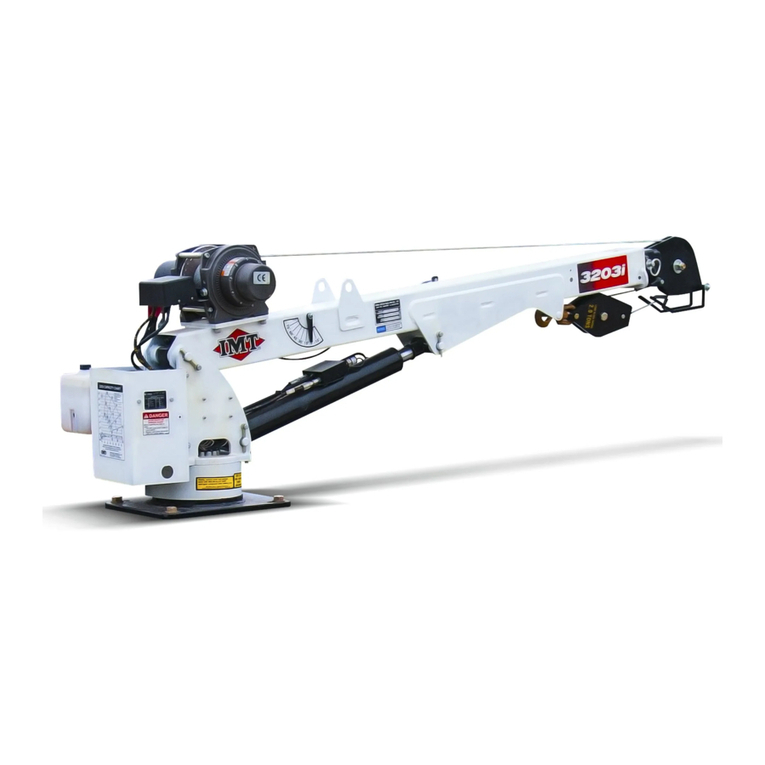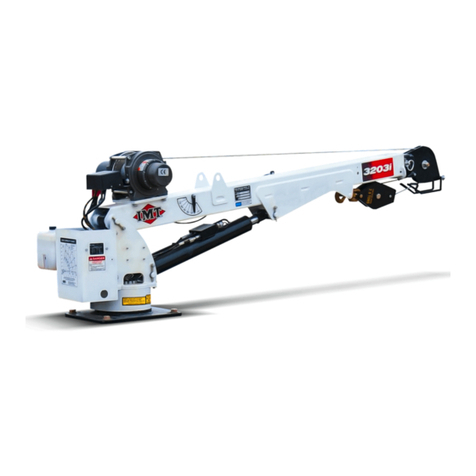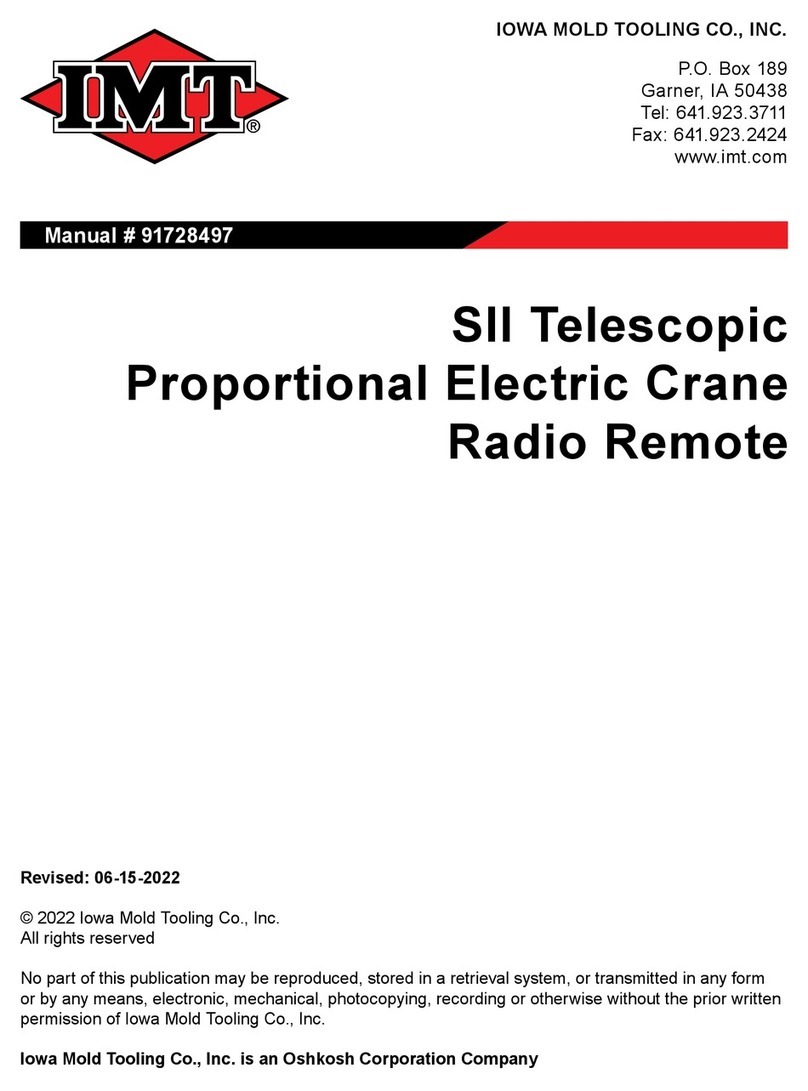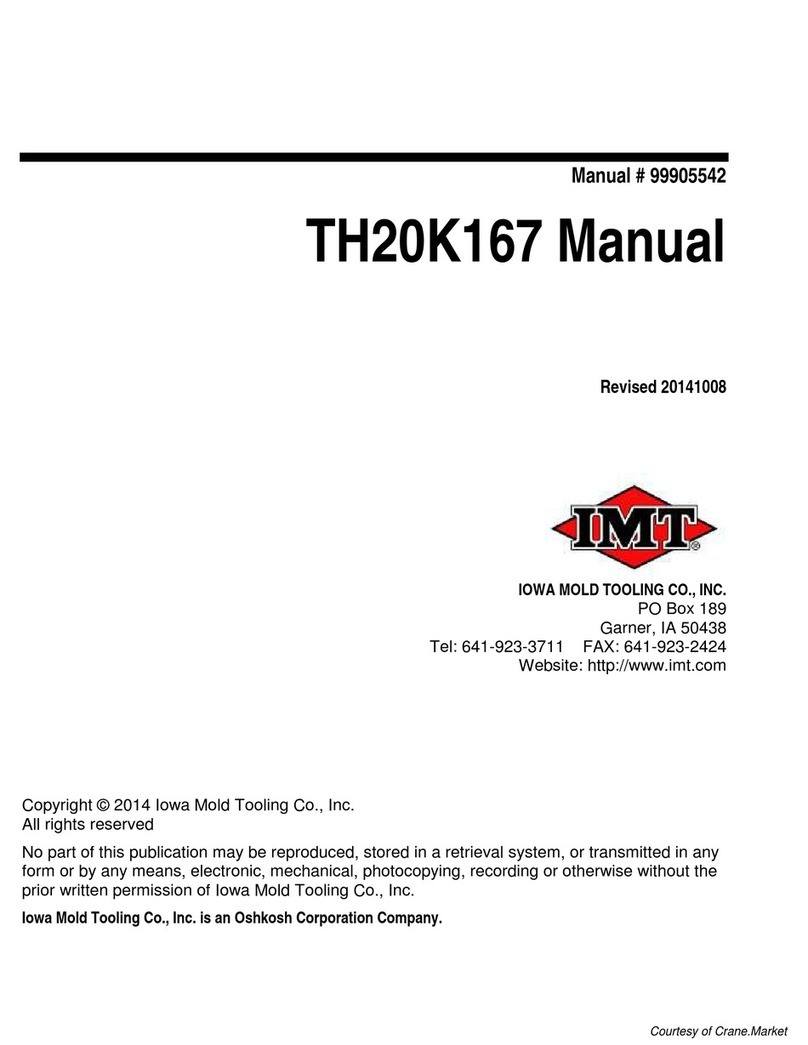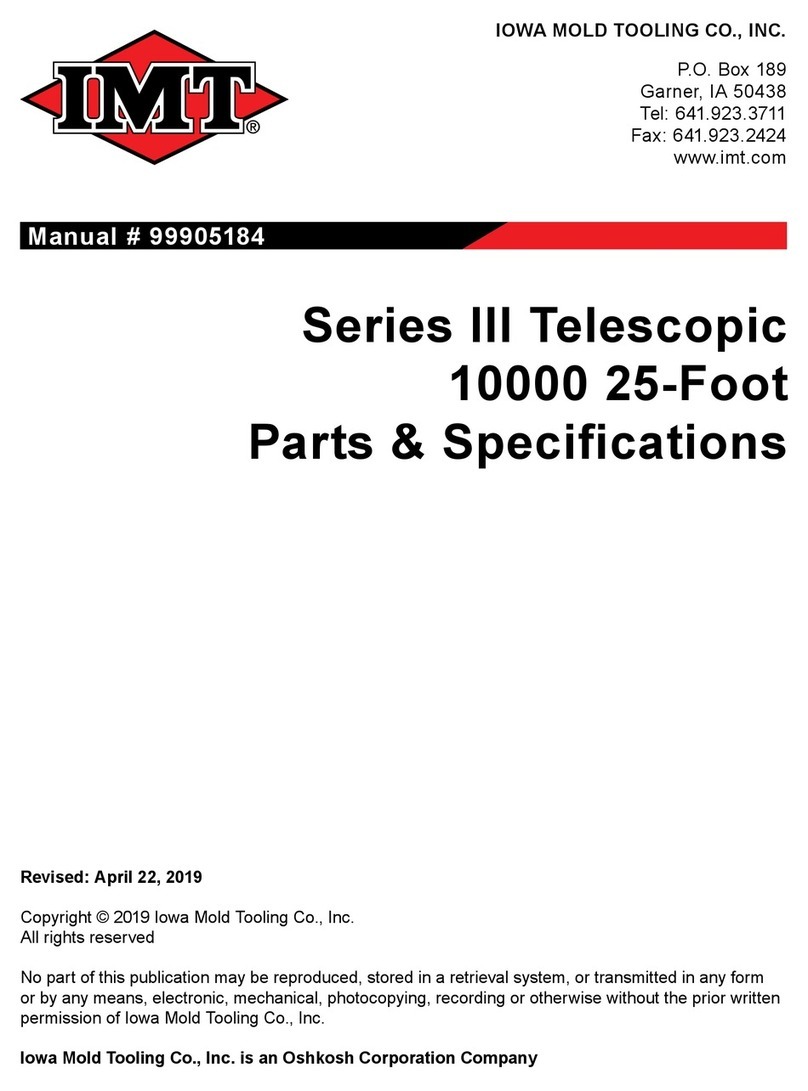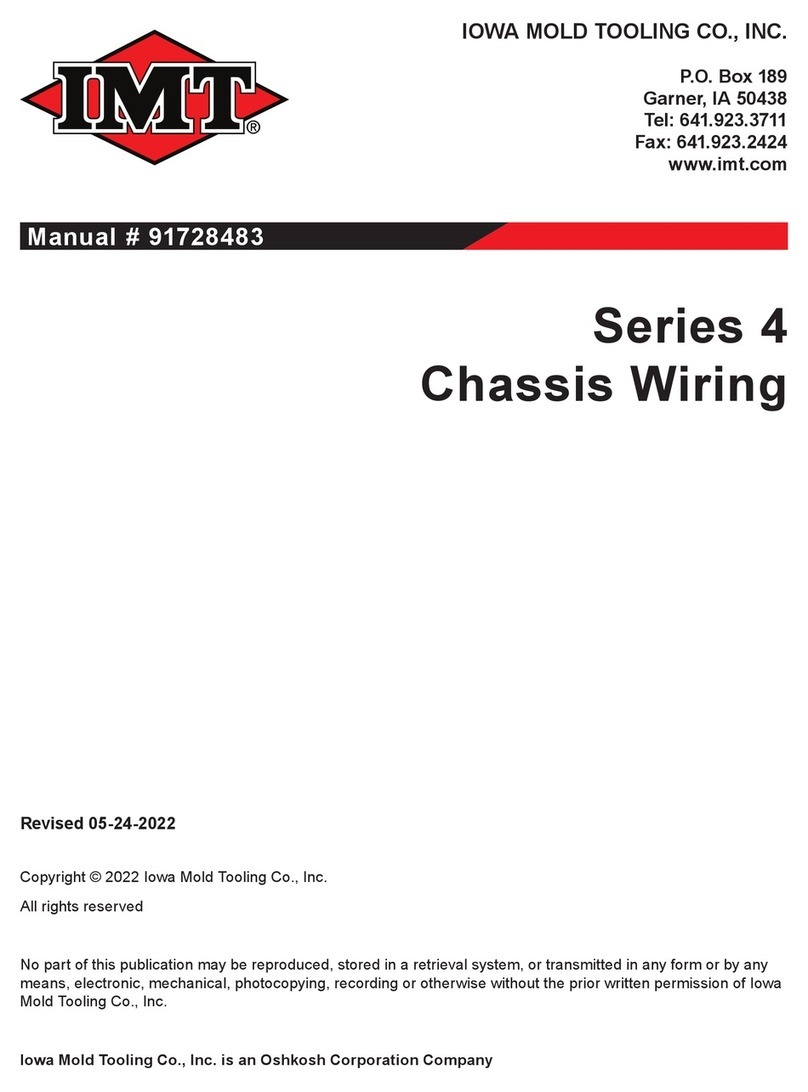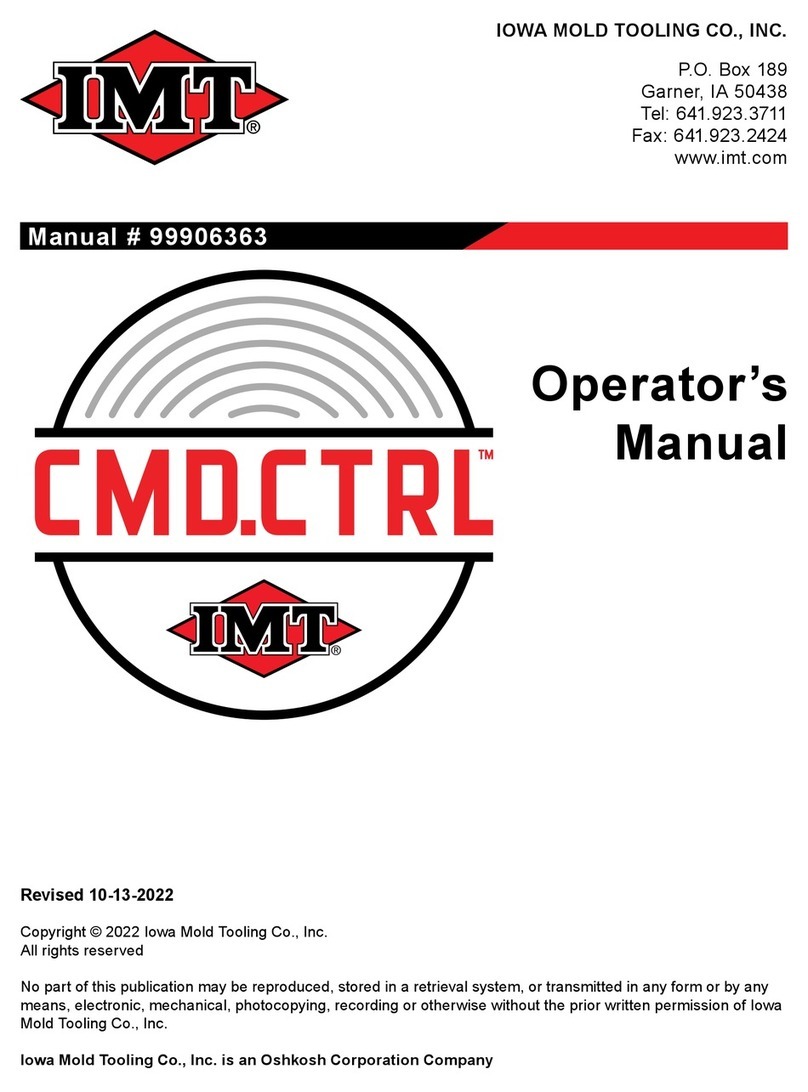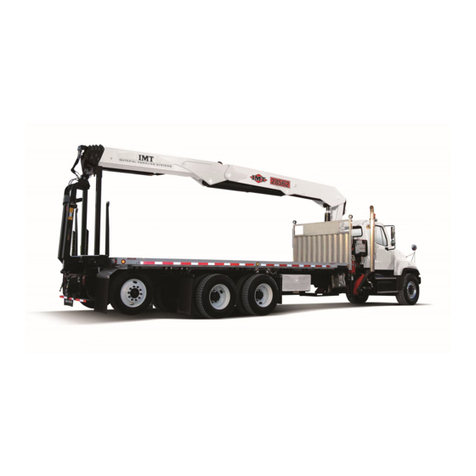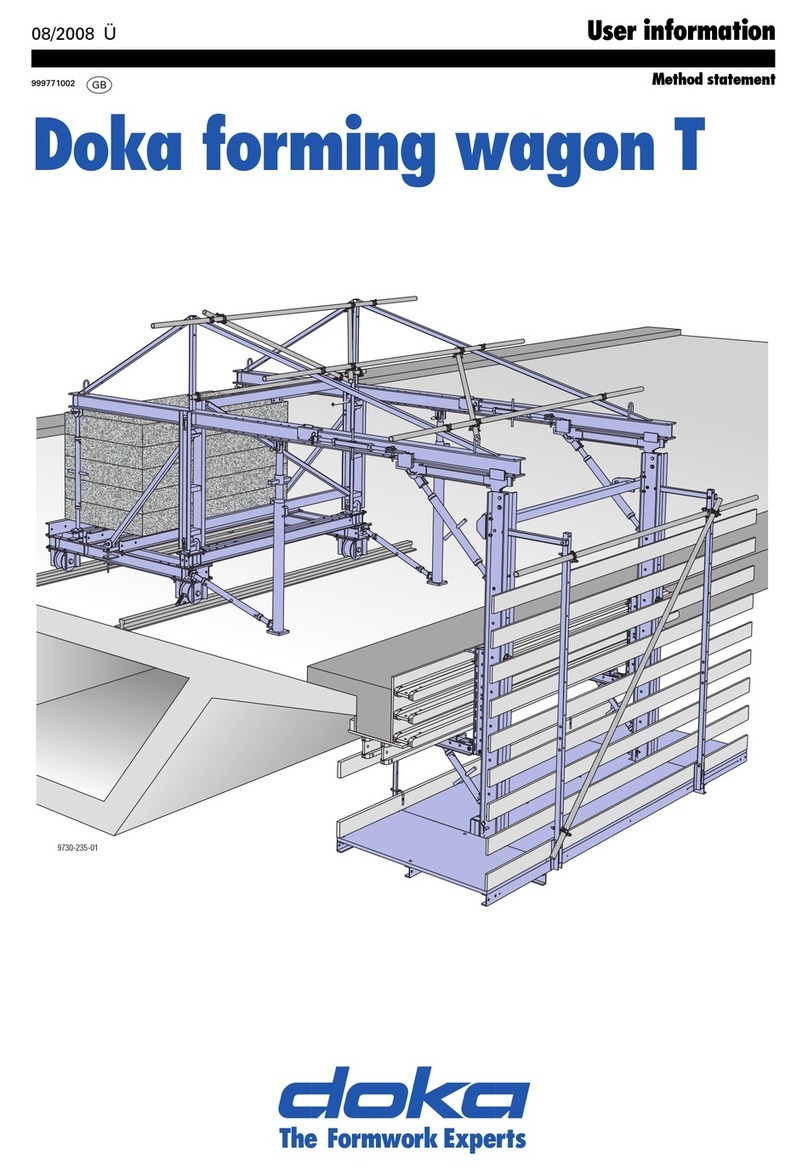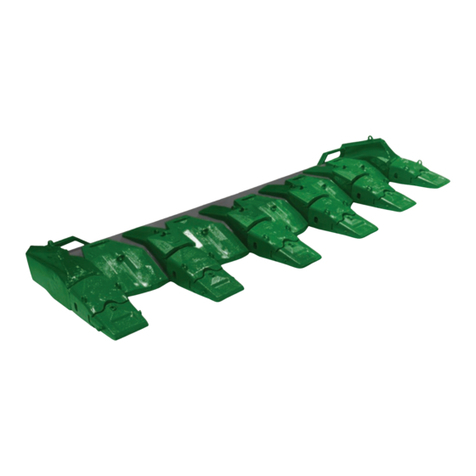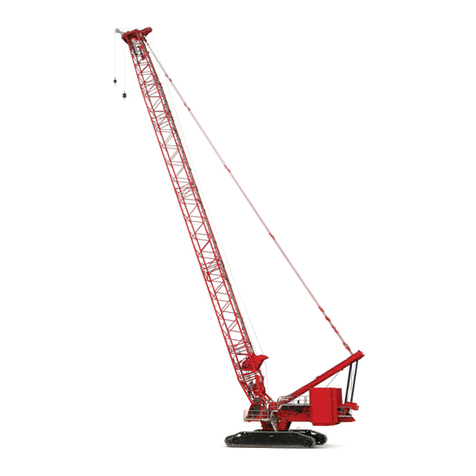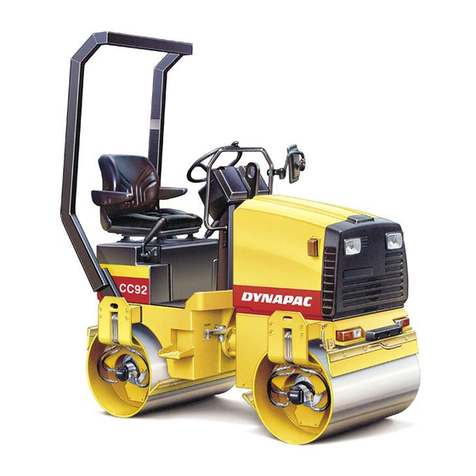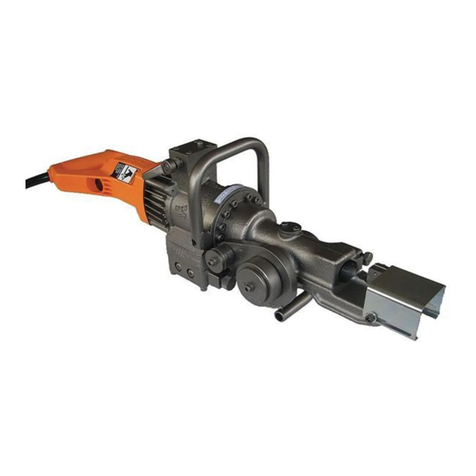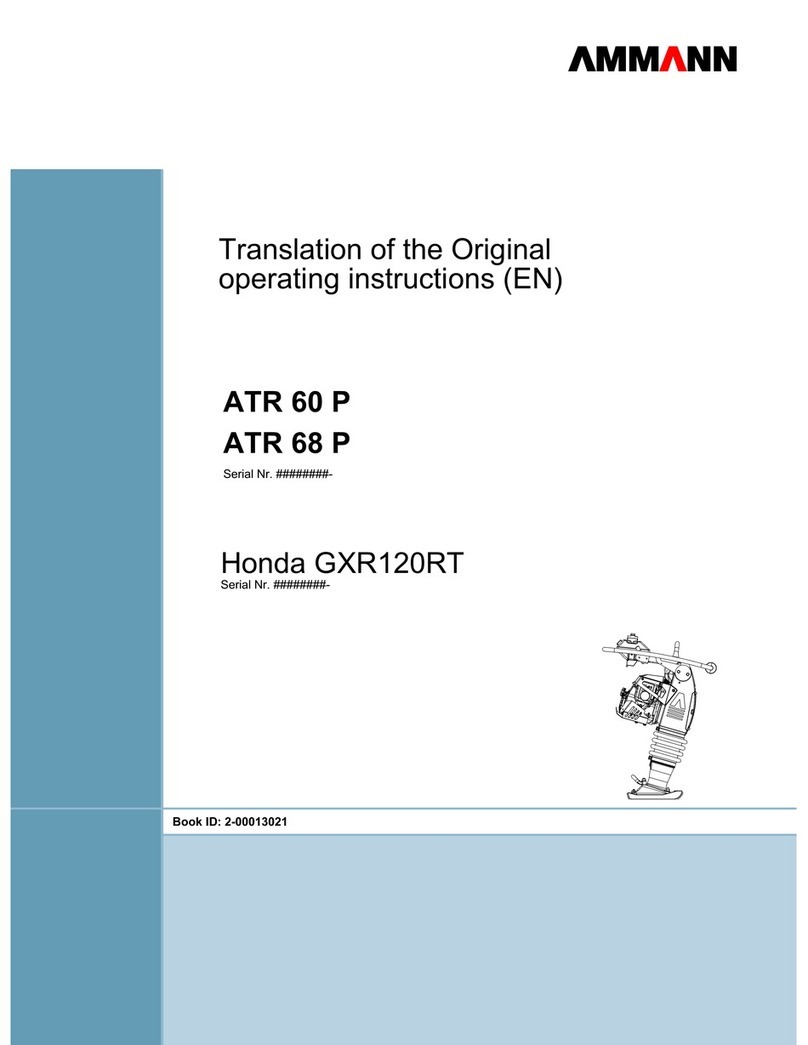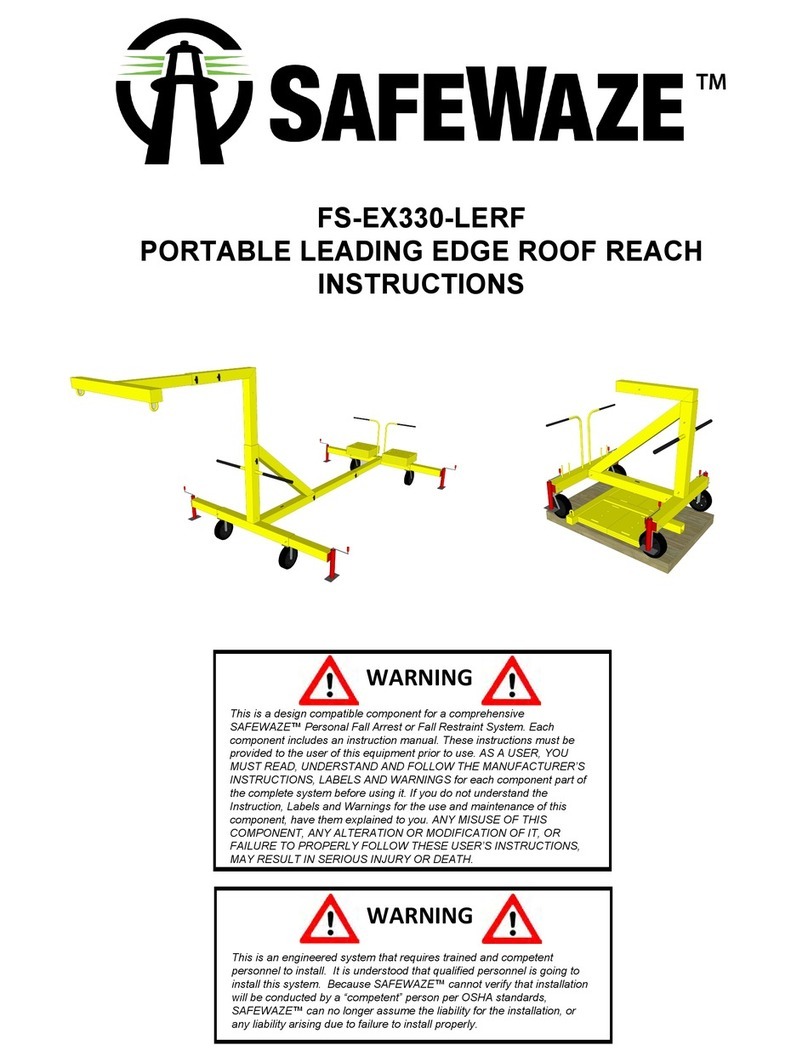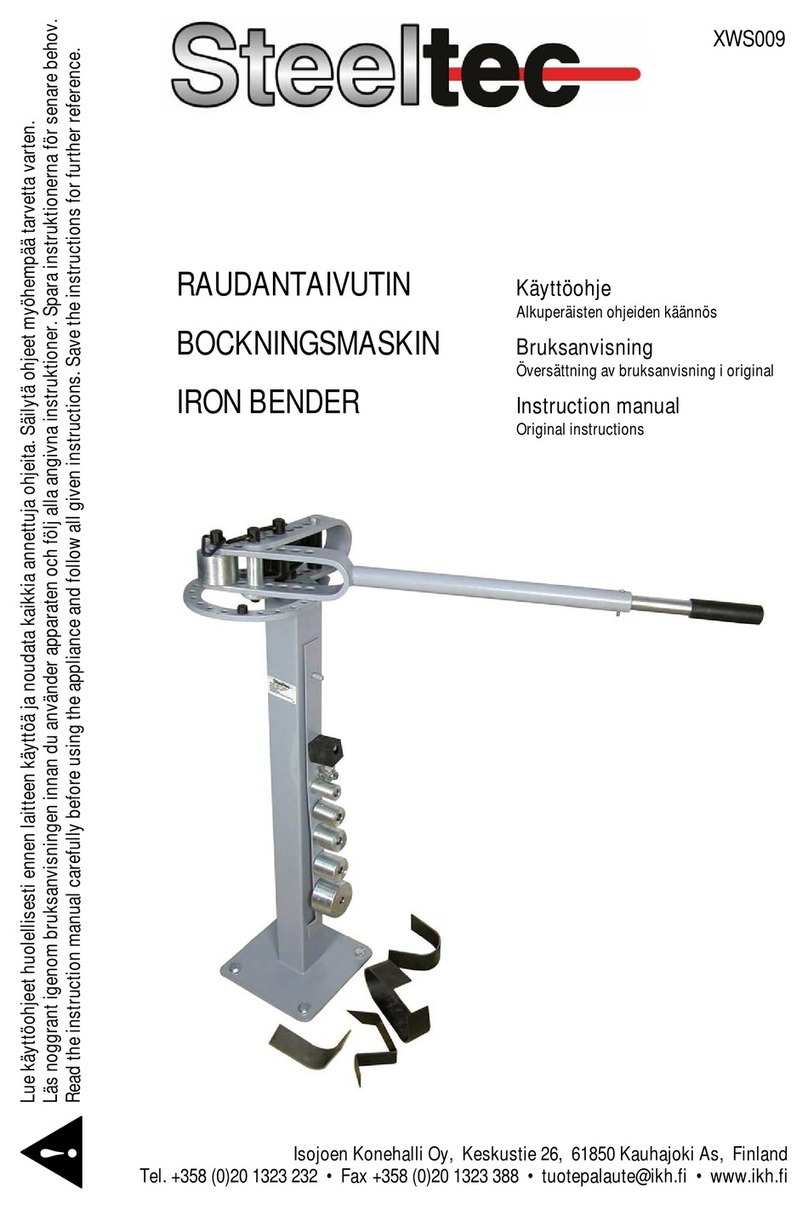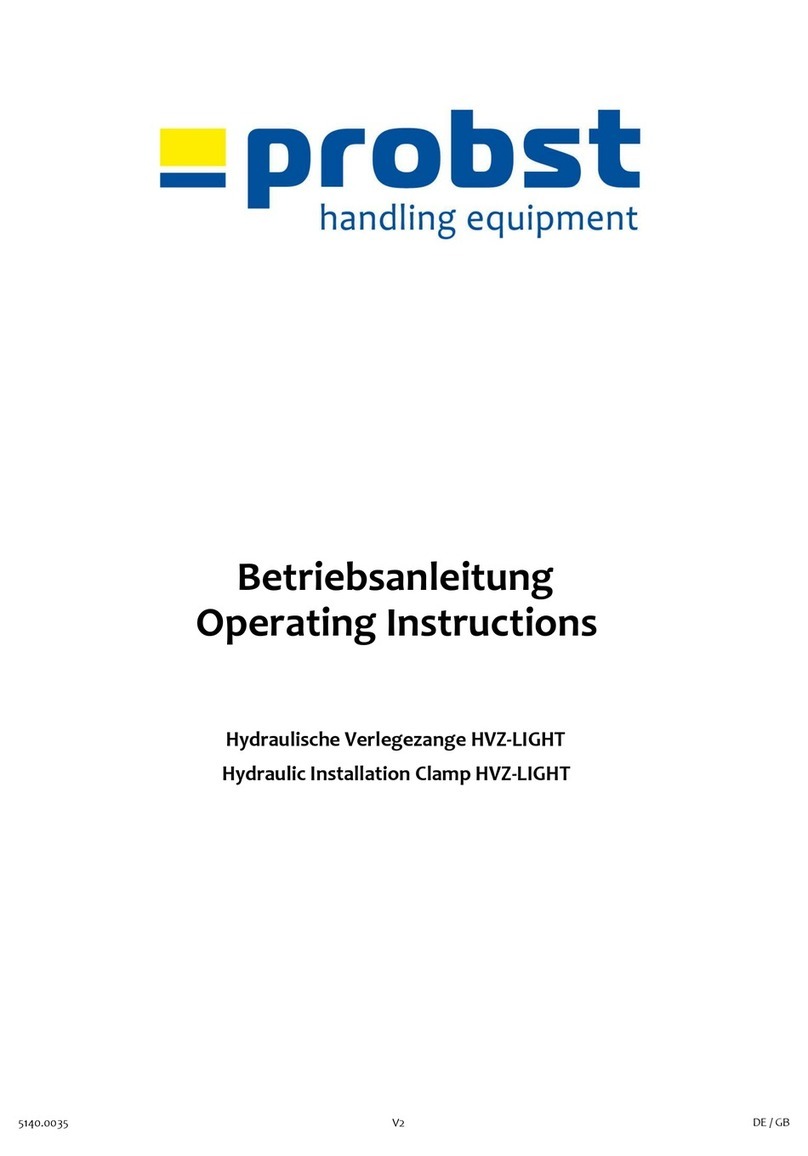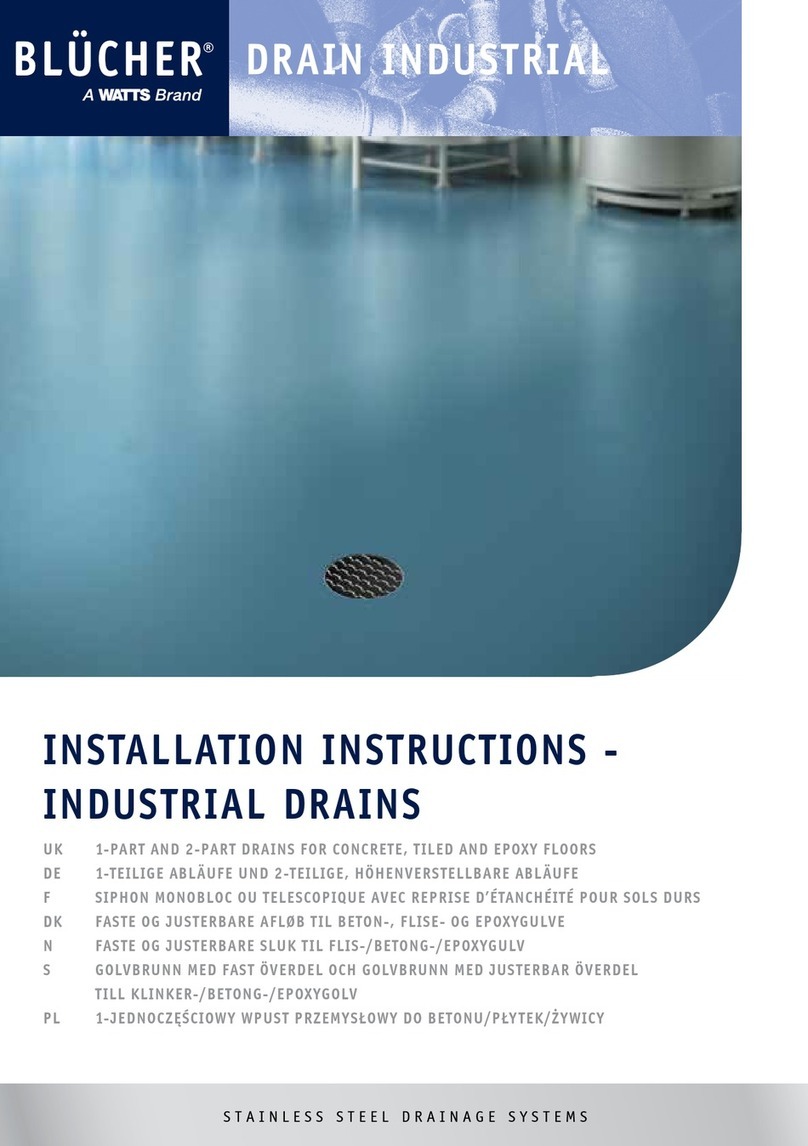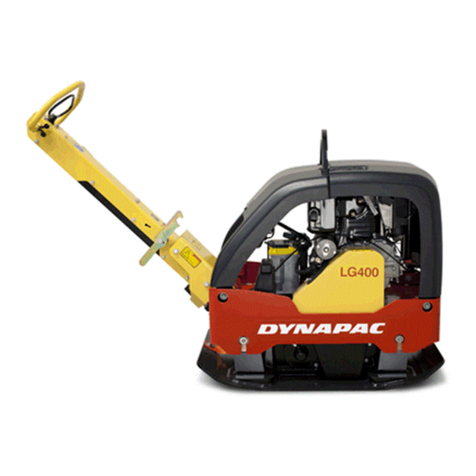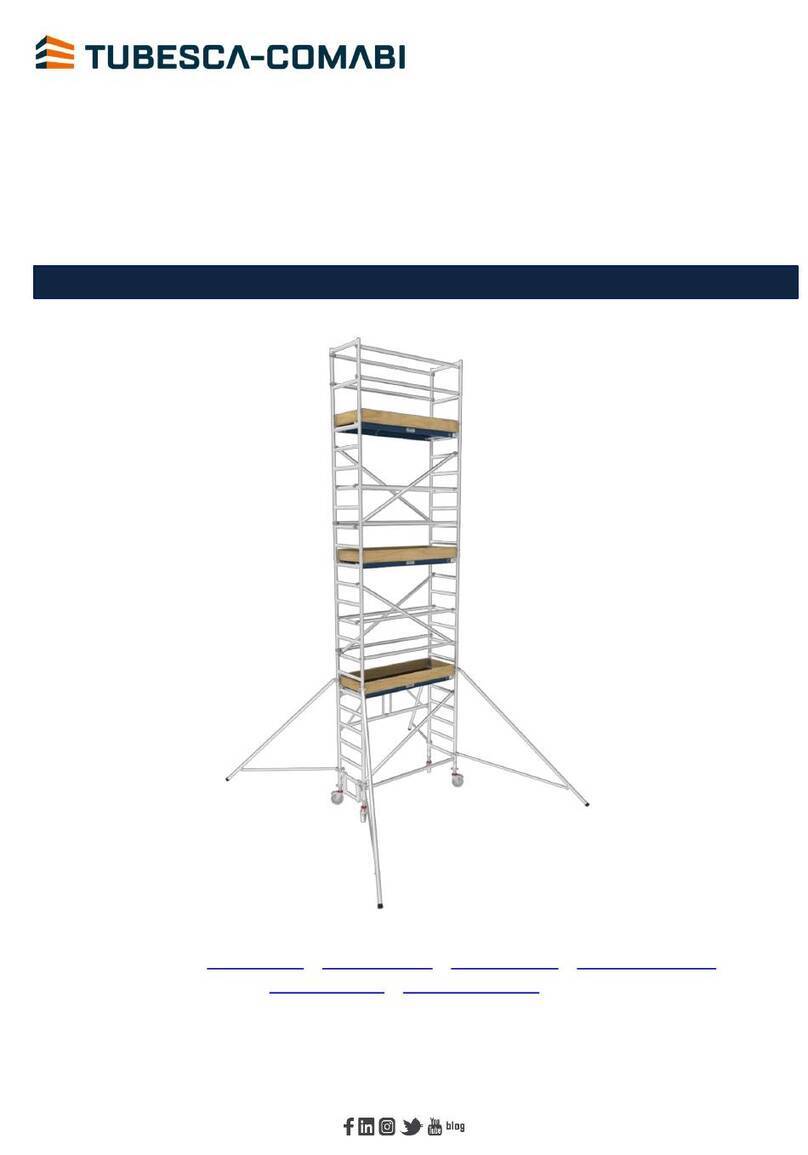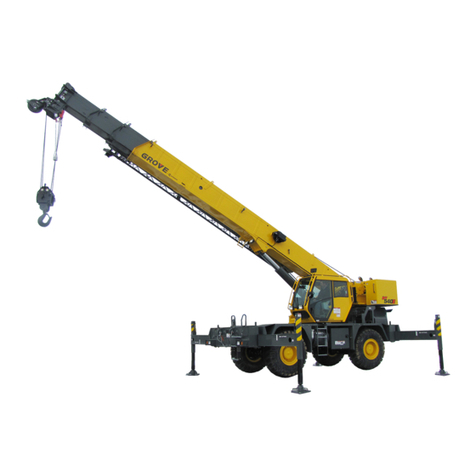IMT 2003i Use and care manual

Oshkosh Corporation Classification: Unrestricted
Manual # 99904381
IMT Electric Cranes
Operation & Safety
Revised 20180530
IOWA MOLD TOOLING CO., INC.
PO Box 189
Garner, IA 50438
Tel: 641-923-3711 FAX: 641-923-2424
Website: http://www.imt.com
Copyright © 2014 Iowa Mold Tooling Co., Inc.
All rights reserved
No part of this publication may be reproduced, stored in a retrieval system, or transmitted in any
form or by any means, electronic, mechanical, photocopying, recording or otherwise without the
prior written permission of Iowa Mold Tooling Co., Inc.
Iowa Mold Tooling Co., Inc. is an Oshkosh Corporation Company.


Oshkosh Corporation Classification: Unrestricted
i
Contents
Revisions .................................................................................................................................................... iii
Introduction 5
Crane Models & Features .............................................................................................................................7
Crane Identification ......................................................................................................................................8
Safety 9
Safety Instructions ......................................................................................................................................10
Daily Safety Inspection...............................................................................................................................12
Electrical Hazards.......................................................................................................................................13
Crane Capacity............................................................................................................................................16
Electric Crane Danger Decal Placement.....................................................................................................17
Work Site Planning.....................................................................................................................................19
Stabilizer Operation....................................................................................................................................20
Ground Support ..........................................................................................................................................21
Winch Safety ..............................................................................................................................................22
Electric Crane Anti Two Block System......................................................................................................23
Holding Valves...........................................................................................................................................24
Double & Single Line.................................................................................................................................25
Operation 27
Electric Crane Start-up and Task Performance...........................................................................................27
IMT Electric Crane Controls ......................................................................................................................29
Tethered Remote Handle Operating Instructions ............................................................................29
Radio Remote Controls ...................................................................................................................30
Proportional Remote Controls.........................................................................................................31

Oshkosh Corporation Classification: Unrestricted
ii Contents
Crane Shut Down........................................................................................................................................33
Operation in Poor Conditions .....................................................................................................................33
Hand Signals...............................................................................................................................................34
Maintenance & Repair 37
Maintenance Introduction...........................................................................................................................38
Electric Crane Power Safety.......................................................................................................................38
Maintenance Schedule................................................................................................................................39
Electric Crane Lubrication..........................................................................................................................39
Grease Zerks...............................................................................................................................................40
Crane Hydraulic Oil Specifications ............................................................................................................40
Electric Crane Power Unit Components .....................................................................................................41
Power Unit Troubleshooting.......................................................................................................................43
Purging Air from Hydraulic System...........................................................................................................44
Hydraulic Pressure Relief ...........................................................................................................................44
Hydraulic Cylinder Holding Capability......................................................................................................44
Pin Removal & Inspection..........................................................................................................................45
Electric Crane Wear Pads ...........................................................................................................................46
Wire Rope Inspection .................................................................................................................................47
Wire Rope Lubrication ...............................................................................................................................48
Wire Rope Maintenance .............................................................................................................................48
Wire Rope Inspection & Replacement........................................................................................................48
Wire Rope Lay............................................................................................................................................50
Additional Inspections................................................................................................................................50
Excessive Load Limitation System.............................................................................................................52
Excessive Load Limitation System (ELLS) Testing .......................................................................52
ELLS Troubleshooting Procedure ...................................................................................................53
Stability Test 55
Crane Stability ............................................................................................................................................56
Stability Chart.............................................................................................................................................58

Oshkosh Corporation Classification: Unrestricted
Contents iii
Revisions
DATE
LOCATION
DESCRIPTION
20090417
Maintenance
Added Wire Rope Lay description.
Stability Test
Added instructions for completing stability test.
20090521
Crane Decals
Revised decal placement drawing to general decals for all models.
20111121
ECN 11628 - Revised wording to stabilizers. Updated safety decals.
20120914
Updated stability test
20140910
Greasing
Instructions
ECN 12264 –Molub-Alloy 882 was Molub-Alloy 936.

Oshkosh Corporation Classification: Unrestricted
iv Contents

Oshkosh Corporation Classification: Unrestricted
5
GENERAL
This manual will help you operate your IMT crane correctly and safely. The manual does not
replace any government regulations, safety codes or insurance carrier requirements. Read and
understand the manual and all safety procedures for this crane prior to operation.
WARNING
Failure to read, understand and follow any
safety procedures for this equipment may
result in death, serious injury or equipment
damage.
Use caution and common sense. Refer to ANSI/ASME B30.5, the standard for Telescoping and
Mobile Boom Cranes, for more information on crane design and test criteria. (Contact the
American Society of Mechanical Engineers at www.asme.org for information on ANSI/ASME
B30.5.) Crane operators must also be familiar with OSHA 29CFR, Subpart N, Article 1926.550
and CAL-OSHA Title 8, Article 93 (California).
CRANE AND SAFETY EQUIPMENT MODIFICATIONS
Do not modify your crane with anything other than IMT approved equipment. If in doubt, contact
IMT prior to making modifications. DO NOT alter or modify any safety device! All safety devices
must be inspected, tested and maintained in proper working condition.
Decals regarding crane safety and operation are safety equipment and must be maintained.
Decals must be kept clean and legible.
OWNER RESPONSIBILITIES
You must maintain and operate this unit for the safest working conditions possible. You must
follow existing Federal, State, and Local codes and regulations governing the safe use and
maintenance, and must make sure anyone involved in equipment operation understands how to
operate and maintain the crane safely. Contact IMT or your IMT distributor for clarification.
WARRANTY
The equipment warranty on this unit will be void on any part of the unit subjected to misuse due
to overloading, abuse, lack of maintenance and unauthorized modifications. No warranty -
verbal, written or implied - other than the official, published IMT new machinery and equipment
warranty is valid with this unit.
CH A P T E R 1
Introduction

Oshkosh Corporation Classification: Unrestricted
6 IMT Electric Cranes Operation & Safety Manual # 99904381
MANUAL STRUCTURE
Throughout the manual, NOTEs, CAUTIONs, WARNINGs and DANGERs are used to draw the
attention of personnel. They are defined as follows:
NOTICE TO THE OWNER / USER
If the crane is involved in a property damage accident, contact your IMT distributor immediately
and provide them with the details of the accident and the serial number of the equipment. If an
accident involves personal injury, immediately notify your distributor and IMT Technical Support
at:
IOWA MOLD TOOLING CO., INC.
500 HWY 18 WEST
GARNER, IA 50438
641 - 923 - 3711
CAUTION
ACAUTION is used when there is the
very strong possibility of damage to the
equipment or premature equipment
failure.
WARNING
A WARNING is used when there is the
potential for personal injuryor death.
NOTE
ANOTE is used to either convey
additional information or to provide
further emphasis for a previous point.
DANGER
Danger indicates an imminently hazardous
situation which, if not avoided, will result
in death or serious injury. Danger is used
in the most extreme situations.

Oshkosh Corporation Classification: Unrestricted
Chapter 1 Introduction 7
Crane Models & Features
VERSIONS & OPTIONS
This manual includes information regarding the following IMT crane models:
▪2003i with Short Mast or Tall Mast
▪3203i with 1 Hydraulic & 1 Manual Extension; 2 Manual Extensions; 1 Hydraulic Extension;
or 1 Manual Extension
▪4004i with 1 Hydraulic & 1 Manual Extension; 2 Manual Extensions; or 1 Hydraulic
Extension; or 1 Manual Extension
▪5005i
▪6006i with 12v or 24v power
These cranes feature:
▪Excess load limit system (ELLS) which senses an overload and prevents winch up, boom
extension and boom down functions.
▪Anti-two block system, which stops the boom extension and/or the winch up functions before
contact is made between the block assembly and the boom.
▪Load holding valves in the hydraulic cylinders which prevent the load from dropping in case
of hydraulic hose failure.
▪Hydraulic system pressure relief valve which prevents excess strain on hydraulic
components.
▪Crane electric power disconnects in the crane cabinet and at the vehicle battery.

Oshkosh Corporation Classification: Unrestricted
8 IMT Electric Cranes Operation & Safety Manual # 99904381
Crane Identification
Every IMT crane has an identification placard (see figure).
SERIAL NUMBER PLACARD
MODEL
NUMBER
SERIAL
NUMBER
MFG
DATE
IOWA MOLD TOOLING CO., INC.
BOX 189, GARNER, IA 50438-0189
PLACARD
CONTENTS
DESCRIPTION
Model Number
Crane model number.
Serial Number
The serial number begins with the crane model
number, followed by the year of manufacturing,
followed by the specific crane number in
consecutive order.
Mfg Date
Date crane was completed.
This placard is attached to the inner boom, mast, or crane base. When ordering parts,
communicating warranty information, or referring to the unit in correspondence, always include
the serial number and model numbers. All inquiries should be addressed to:
Iowa Mold Tooling Co., Inc.
Box 189, Garner, IA 50438-0189
Telephone: 641-923-3711
Technical Support Fax: 641-923-2424

Oshkosh Corporation Classification: Unrestricted
9
In This Chapter
Safety Instructions.................................................................... 10
Daily Safety Inspection............................................................. 12
Electrical Hazards .................................................................... 13
Crane Capacity ........................................................................ 16
Electric Crane Danger Decal Placement .................................. 17
Work Site Planning................................................................... 19
Stabilizer Operation.................................................................. 20
Ground Support........................................................................ 21
Winch Safety............................................................................ 22
Electric Crane Anti Two Block System...................................... 23
Holding Valves ......................................................................... 24
Double & Single Line................................................................ 25
CH A P T E R 2
Safety

Oshkosh Corporation Classification: Unrestricted
10 IMT Electric Cranes Operation & Safety Manual # 99904381
Safety Instructions
WARNING
Keep children, by-standers, and persons not
required in the operation of equipment at
least 10’-0” (3.05 m) from the outermost
range of the crane.
SAFE CRANE OPERATION
▪Do NOT operate crane unless you have been trained in safe operation.
▪Read, understand, and follow manual, labels, safety instructions, and your employer’s work
rules.
▪Make sure guards, safety signs, and safety features are in place and in good condition.
▪Read, understand and follow the crane load and work area charts. Do not exceed crane or
winch ratings.
▪Keep three wraps of loadline on winch.
▪Operate crane controls slowly and smoothly.
▪Know the position of the booms at all times while operating the crane. Eliminate swing by
positioning the boom tip directly over the center of the load before lifting.
▪Do NOT operate in excessive wind speeds.
▪Keep load under boom tip. Do NOT side load boom, drag, or swing loads.
▪Stow boom and stabilizers before traveling.
▪Do not allow anyone to ride crane boom, hook, or load.
▪Follow all inspections and maintenance practices listed in manuals.
▪To protect the vehicle, position the truck so that lifting does not take place over the cab.
ELECTRICAL SYSTEM
This crane operates using electrical power from the vehicle battery.
DANGER
Avoid electrocution! Do NOT work on the
crane before turning off the crane power
supply in the crane cabinet and removing
the crane power disconnectcable from
the vehicle battery.

Oshkosh Corporation Classification: Unrestricted
Chapter 2 Safety 11
ANTI-TWO BLOCK
Do NOT permit the lower load block or hook assembly to contact the upper load block or boom
point sheave assembly. This is two blocking. IMT telescoping cranes with a winch are equipped
with an anti-two blocking device, but the crane operator must avoid two-blocking and must not
rely on the device alone.
DUTY CYCLES
This electric crane operates using a power unit with a maximum duty cycle of 5 minutes. See
the technical specifications for pump performance charts and operating intervals.
CAUTION
Avoid motor damage! The DC electric
motor can overheat. Run for short periods
to avoid overheating.
EXTENSION SEQUENCE
Always extend the hydraulic extensions first, followed by the manual extensions. When
retracting, retract the manual extensions prior to the hydraulic extensions.
OVERLOAD PROTECTION SYSTEM (ELLS)
IMT cranes are equipped with an excess load limitation system (ELLS), or overload protection
system. In an overload condition, no function will operate which results in an increase in
operating radius. However, the same function may be operated in the opposite direction if it
results in decreased operating radius. Note that the overload protection system is not sensitive
to vehicle stability -- it is still possible to cause vehicle instability. The operator cannot substitute
the overload protection system for good judgment. Refer to the capacity chart before attempting
to lift a load.
STABILITY
Use crane on solid, level surface with stabilizers properly extended, and keep vehicle level.
Reduce loads when operating on uneven ground. Keep personnel clear of moving stabilizers.
When you rotate the crane, the load may change from being supported by the stabilizers to the
vehicle suspension. Be cautious as you rotate the crane, because the springs on the carrier
vehicle will respond differently to the load than the tires will.
WINCH
Never use the winch to drag a load into position before lifting. This may sideload the crane or
stress the wire rope beyond safe limits. Equipment damage may result.
When using a winch, always keep the tip of the extension boom as close to the load as practical.
This will prevent the load from swinging out of control when using the rotation (swing) function.

Oshkosh Corporation Classification: Unrestricted
12 IMT Electric Cranes Operation & Safety Manual # 99904381
DANGER
DO NOT permit personnel to ride the
boom, loadline, hook or load, as this
action may causeDEATHor serious injury.
Use only specified wire rope for lifting. Retain at least three full wraps of wire rope on the winch
drum at all times.
WIRE ROPE
Before extending the boom, always pay out the wire rope. Failure to do so may overstress the
wire rope and cause a two block condition.
Daily Safety Inspection
Use the Crane Log, IMT Manual No. 99900686, the inspection checklist in the reference section
of this manual, or the following list when inspecting your unit at start-up and during operation:
1 Vehicle - Check oil level, battery, lights, brakes, and tires for inflation, pressure, cuts, and
loose or missing wheel lugs.
2 Safety Accessories - Check for proper function, oil levels, leaks and malfunctions.
3 Hydraulic Oil Reservoir - Check for proper oil level, leaks and blockages.
4 Weldments - Check visually for damage, especially cracks or breaks in welds.
5 Cylinders - Check for leakage and scored rods.
6 Fasteners - Check pins, sheaves, nuts and bolts for breakage, excessive wear and
tightness.
7 Crane Hooks - Check for the presence of a safety catch, twists, cracks, or damage.
8 Ropes & Slings - Check for frayed edges, broken strands, kinks, flat spots, and end
attachments.
9 Covers and Guards - Check for missing or improperly maintained covers and guards.
10 Operation Placards and Safety Decals - Check for illegible or missing decals and placards.
Refer to the decal section of this manual for more information on the required decals.
Replace or repair any items as needed prior to equipment operation.

Oshkosh Corporation Classification: Unrestricted
Chapter 2 Safety 13
Electrical Hazards
DANGER
ELECTROCUTIONHAZARD
▪Vehicle is not insulated.
▪Do NOT raise boom into power lines.
▪Look up and use light to search for power lines in the dark.
▪Keep boom and vehicle a minimum of 20 ft. (6.1 m) away from power lines.
▪Do not step off a charged vehicle.
▪If you touch a charged vehicle while standing on the ground, you will die.
Overhead power lines are not insulated. While some lines have a weather covering and appear
to be insulated, they are not. The vehicle or parts of the vehicle do not need to touch the power
line for the vehicle to become energized. Electricity will arc across gaps, and all overhead wires
or cables should be considered hazardous and dangerous. Always operate the crane so that no
part of the crane or load enters the "Danger Zone", the minimum clearance distance for a
powerline.
DANGER
VOLTAGEHAZARD
The danger zone of a particular powerline is based on its voltage. High voltage levels increase
the danger zone. See figure.
DANGER ZONE
AVOID THIS AREA.
DANGER ZONE FOR CRANES
OPERATING NEAR ELECTRICAL
POWERLINES

Oshkosh Corporation Classification: Unrestricted
14 IMT Electric Cranes Operation & Safety Manual # 99904381
70394445
DANGER
Electrocution Hazard
Never approach this vehicle or the
load if it is near power lines.
Death or serious injury will result from
touching or being near this vehicle if it
becomes charged.
REQUIRED CLEARANCE OF CRANES FROM ELECTRICAL TRANSMISSION LINES
NORMAL VOLTAGE
kV (Phase to Phase)
MINIMUM CLEARANCE REQUIRED
Feet (meters)
OPERATION NEAR HIGH
VOLTAGE POWERLINES
From 0 to 350
20 (6.10)
Above 350 or unknown
50 (15.24)
OPERATION IN TRANSIT WITH
NO LOAD AND BOOM OR MAST
LOWERED
From 0 to 0.75
4 (0.22)
From 0.75 to 50
6 (0.83)
From 50 to 345
10 (3.05)
From 345 to 750
16 (4.87)
From 750 to 1000
20 (8.10)
GUIDELINES WHEN WORKING AROUND POWER LINES:
▪Make sure the work area is clear of major obstacles and overhead obstructions
▪Do not work within 20 feet (6.10 m) of high-voltage lines energized up to 35,000 volts, and
50 feet (15.24 m) of high-voltage lines energized up to 50,000 volts or of unknown voltage. It
is the law. The operator can be liable if activities in violation of this law cause injury or
property damage.
▪Only operate in conditions where the vehicle and equipment can be stabilized. Do not set up
or operate on soft soil, mud, snow or other unstable ground conditions that could allow the
vehicle or equipment to shift and move within 20 feet (6.10 m) of a power line.
▪Look up and live. Always check the operating vicinity for power lines before you drive into it.
Tree branches can hide power lines or cables from view. If operating at night, use powerful
lights to search for power lines or poles.
▪During windy conditions, allow additional clearance.
▪Do not rely on cage-type boom guards, insulating links, or proximity warning devices for
safety. Adhere to the required distances listed in table titled REQUIRED CLEARANCE OF
CRANES FROM ELECTRICAL TRANSMISSION LINES.
▪Contact the utility company before beginning work near powerlines.
▪Always assume overhead lines to be energized.
▪Avoid transporting a crane over uneven terrain.

Oshkosh Corporation Classification: Unrestricted
Chapter 2 Safety 15
▪When using rope to steady a load or restrain spinning of the load, be aware that rope will
also conduct electricity, especially if wet or damp.
▪Reduce operating speed when in close proximity to powerlines in order to allow the operator
more reaction time.
IF ELECTRICAL CONTACT OCCURS:
1 If you are on or inside a vehicle that contacts or is energized by a power line, stay where you
are. Exiting the vehicle is more hazardous than remaining inside. Unless there is a fire, it is
safer to stay in the vehicle than to attempt an exit. Stay in or on the vehicle until a power
company representative informs you that the line has been de-energized and grounded and
that the area is safe.
2 If it is critical that you leave the vehicle, JUMP as far away as possible landing with both feet
together. Maintain balance or fall forward, don’t fall back towards the vehicle which could
result in the body becoming a pathway between the vehicle and the ground. No part of your
body should touch the vehicle and the ground at the same time.
3 If you are outside of the vehicle that contacts or is energized by a power line, move away
from the vehicle and stay away. Warn others to stay away. You are safe from electrical
shock as long as you do not become a pathway for current to flow to the ground. Do not
approach the vehicle until a power company representative informs you that the line has
been de-energized and grounded and that the area is safe
4 In certain circumstances the ground around a charged vehicle or downed power line may be
energized. The ground becomes charged in concentric circles around the vehicle with
varying voltage potential. Straddling these bands can result in serious injury or death as the
current passes through your body. Stay away from the vehicle or power line, keeping both
feet on the ground at the same time. This will prevent you from becoming a conductor
between two areas of the ground that are charged differently.
5 If someone is trapped inside a vehicle that has come in contact with a power line, instruct
them to stay inside and not to try to exit, unless their life is in eminent danger or a fire is
present. Call 911 immediately and instruct the 911 operator to contact the power company.
The power company personnel are trained to eliminate the hazard by de-energizing the line.
6 Do not attempt any rescue a person on or inside an energized vehicle, or who is energized
themselves. If you touch someone whose body is conducting current, the current will flow
through you too. Your muscles will seize up and you will not be able to escape.
ELECTRICAL CONTACT FOLLOW-UP:
1 Inspect and repair any equipment affected by electrical contact.
2 Replace any wire rope which has had high voltage contact.

Oshkosh Corporation Classification: Unrestricted
16 IMT Electric Cranes Operation & Safety Manual # 99904381
Crane Capacity
The IMT crane is designed to lift specific loads. These loads are defined on the capacity placard
mounted near the operator’s station and on the crane. Exceeding the limits presented on the
capacity placard will create severe safety hazards and will shorten the life of the crane. The
operator and other concerned personnel must know the load capacity of the crane and the
weight of the load being lifted!
The capacity chart for each model is located in the specific crane technical specifications manual
and on placards on the crane and body.
WARNING
Never exceed the crane’s rated load
capacities. Doing so willcause structural
damage towinchesand cables which can
lead todeath or serious injury.
NOTE
Capacity Placards are intentionally located
nearthe operator to assure ready reference
in determining when a load can or cannot be
handled.
Load limit information on the capacity
placards is formulated on 85% of tipping.
Tipping refers tothe crane actuallytipping
with its opposite stabilizer and tires having
broken contact with the surface.
Prior to lifting a load:
1 Determine the weight of the load.
2 Determine the weight of any load handling devices.
3 Add the weight of the load and the weight of the load handling devices. The sum is the total
weight of the load being lifted.
4 Determine the distance from the centerline of crane rotation to the centerline of the load
being lifted.
5 Determine the distance from the centerline of crane rotation to the centerline of where the
load is to be moved to.
6 The actual distance used should be figured as the larger of items 4 and 5 above.

Oshkosh Corporation Classification: Unrestricted
Chapter 2 Safety 17
Electric Crane Danger Decal Placement

Oshkosh Corporation Classification: Unrestricted
18 IMT Electric Cranes Operation & Safety Manual # 99904381
Additional danger decals are applied inside the truck body door. These decals include the
following.
DISTANCE IN FEET/ METERS / LOAD IN POUNDS/ KG
FollowSafe Operating & Inspection Procedures
Electrocution Hazard
Crane and remote control are not insulated.
70396613
Falling Load Hazard
Death or serious injury will result from approaching or contacting a power line.
Falling loads may injure or kill.
Fall Hazard
Riding on boom, hook, or loadline may injure or kill.
Overload Hazard
Overloading the crane may injure or kill.
WARNING
Weightofload handling devices are partofthe load lifted
and mustbe deducted from the capacity.
There are two warning decals applied to the front, sides and rear of the carrier vehicle.
Other manuals for 2003i
1
This manual suits for next models
4
Table of contents
Other IMT Construction Equipment manuals
